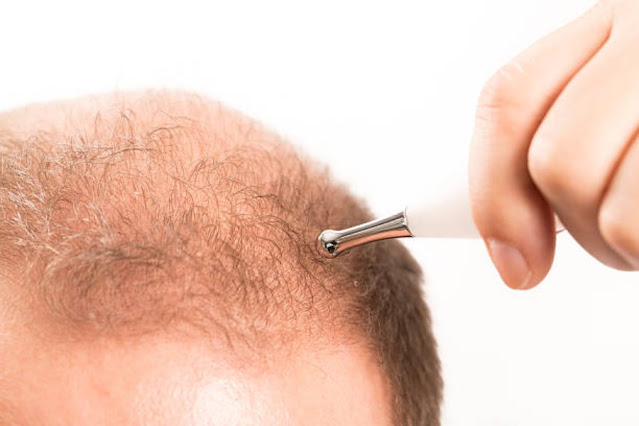
Introduction:
Hair loss is a common condition that can significantly
impact an individual's appearance and self-esteem. While various treatment
options are available, topical treatments have gained popularity due to their
convenience and non-invasive nature. This article provides a comprehensive
overview of topical treatments for hair loss, discussing the most effective
options, their mechanisms of action, usage guidelines, effectiveness, and
potential side effects.
Understanding Hair Loss:
Before delving into topical treatments, it is vital to
understand the underlying causes of hair loss. Common types of hair loss
include androgenetic alopecia (pattern baldness), alopecia areata
(autoimmune-related hair loss), and telogen effluvium (temporary shedding).
These conditions involve complex mechanisms that disrupt the normal hair growth
cycle and lead to hair thinning or loss.
Mechanisms of Action of Topical Treatments:
Topical treatments for hair loss target specific mechanisms
involved in hair growth and aim to promote hair follicle health and stimulate
hair regrowth. The means of action can include:
a. DHT Inhibition: Dihydrotestosterone (DHT) is a crucial
hormone in androgenetic alopecia. Topical treatments containing DHT inhibitors,
such as minoxidil, finasteride, or dutasteride, help reduce the effects of DHT
on hair follicles.
b. Vasodilation: Some topical treatments improve blood
circulation to the Scalp, delivering essential nutrients and oxygen to hair
follicles. This can be achieved through ingredients like vasodilators (e.g.,
minoxidil) or scalp massage techniques.
c. Anti-inflammatory Effects: Inflammatory processes can
contribute to hair loss. Topical treatments containing anti-inflammatory
agents, such as corticosteroids or natural extracts, help reduce inflammation
in the Scalp and promote a healthier environment for hair growth.
d. Nutrient Supply: Certain topical treatments provide
essential nutrients, vitamins, and minerals directly to the Scalp, nourishing the
hair follicles and supporting their growth and health.
Effective Topical Treatments for Hair Loss:
a. Minoxidil: Minoxidil is one of the most widely used
topical treatments for hair loss. It is over-the-counter and comes in various
formulations (liquid or foam). Minoxidil is thought to work by prolonging the
growth phase of the hair cycle and promoting blood flow to the Scalp. It is
effective for androgenetic alopecia in both men and women.
b. Finasteride: Finasteride is an oral medication primarily
used for treating male pattern baldness. However, topical formulations of
finasteride have also been developed. It works by inhibiting the conversion of
testosterone to DHT, which helps slow down hair loss and promote hair regrowth.
c. Ketoconazole: Ketoconazole is an antifungal medication that has shown potential in treating hair loss. It has anti-inflammatory properties and may also inhibit DHT. Ketoconazole is available in both prescription-strength shampoos and topical solutions.
d. Natural Extracts and Essential Oils: Various natural
extracts and essential oils, such as saw palmetto, rosemary oil, and peppermint
oil, have shown promising results in promoting hair growth and reducing hair
loss. These botanical ingredients often possess anti-inflammatory, antioxidant,
and anti-androgenic properties.
Guidelines for Usage:
When using topical treatments for hair loss, it is vital to
follow specific guidelines to ensure optimal results:
a. Consistency: Consistent application is crucial for the effectiveness
of topical treatments. It is typically recommended to apply the treatment once
or twice daily, as directed by the manufacturer or healthcare professional.
b. Scalp Preparation: It is vital to ensure a clean and dry
scalp before applying topical treatments, and this allows for better absorption
and efficacy.
c. Massage Techniques: Gentle massage techniques, such as
circular motions or tapping, can be used when applying topical treatments.
Massaging the Scalp helps improve blood circulation and enhance the penetration
of the medicine into the hair follicles.
d. Patience: Results from topical treatments for hair loss
may take time to become noticeable. It is essential to have realistic
expectations and continue using the medicine as recommended for several months
before evaluating its effectiveness.
Conclusion:
Topical treatments for hair loss offer a convenient and
non-invasive approach to address hair thinning and promote hair regrowth. While
minoxidil remains the most widely used and extensively studied topical
treatment, other options, such as finasteride, ketoconazole, and natural
extracts, show promise in combating hair loss. It is essential to consult with
a healthcare professional or dermatologist to determine the most suitable
topical treatment based on individual needs and ensure proper usage and
monitoring for optimal results.